The World Cup 2018 quarter-finals are here and we are at a point in the competition where any weakness is magnified. This was clear in the Round of 16 as the weaknesses of several teams were exposed mercilessly. Argentina’s weak defence was torn apart by Kylian Mbappe, Switzerland could not get a goal from Haris Seferovic and Spain’s lack of a Plan B proved fatal against Russia.
All of those weaknesses led to those teams being knocked out in the Round of 16. Others (like those of teams below) managed to advance despite their flaws. So what are the weaknesses of some of the teams that made the quarter-finals?
France: Inability to Break Down a Deep Defense

This really should not be a ‘weakness’ for the Les Blues as they arguably have the best attacking talent of anyone in the competition with the likes of Kylian Mbappe, Antoine Griezmann, Thomas Lemar, Paul Pogba and Ousmane Dembele. However, Didier Deschamps has chosen to be conservative with his tactics: playing defensive midfielder Blaise Matuidi as a left-winger and preferring Oliver Giroud instead of more dynamic players.
This has led to a situation where France struggle to break down defenses which sit deep. They only managed to score two against Australia (with one being an own goal), one against Peru and none against Denmark. Even against Argentina, two of their four goals came as a result of counter-attacks while Benjamin Pavard’s goal won’t be repeated any time soon. Overall in the group stages, France only took 3% of their shots within the 6 yard box tied for eighth-least among teams in the tournament. This suggests an inability to break down defenses.
What makes this so worrying for France is that they are about to face one of the best defensive teams in the tournament: Uruguay. The South American team likes to sit deep and thus France’s attack may struggle in the game.
Uruguay: Lack of Midfield Creativity
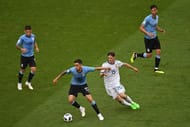
However, Uruguay also have a major weakness that may prove fatal in the quarter-final. Like most Uruguay teams of the past decade, manager Oscar Tabarez has an incredible defence and a brilliant strike-force at his disposal. Uruguay have only conceded one goal at the tournament. On the other side of the pitch, Luis Suarez and Edinson Cavani have been outstanding. However, Uruguay’s perennial problem persists in their midfield.
Tabarez has decided that he would rather focus on defensive solidity in midfield- playing defensively-minded midfielders like Lucas Torreira, Mathias Vecino and Nathan Nandez. This has mostly worked as Torreira particularly has been excellent, especially against Portugal. Nevertheless, this has resulted in a situation where Uruguay barely have any creativity in midfield. Their midfield quartet (Torreira, Vecino, Nandez and Rodrigo Bentancur) has averaged a total of 1.4 key passes per game- less than 75 individual players in the tournament.
This creative void has affected Uruguay’s attack; they have only scored two goals from open play, both of which came against Portugal and involved moments of genius from Cavani and Suarez. Considering the quality of France’s centre-back duo (Samuel Umtiti and Raphael Varane), Suarez and Cavani may not have a similar impact against Les Blues. In that situation, Uruguay’s lack of midfield creativity may be an issue.
Russia: Lack of Defensive Pace
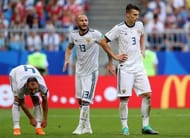
This is probably not Russia’s biggest weakness; that would be their simple lack of talent. Unlike any other team in the quarter-finals, none of their players play for Europe’s top clubs and only one (Denis Cheryshev) plays in one of Europe’s top leagues. However, that lack of talent hasn’t been a roadblock for the Russians so far. They have advanced to the quarter-finals as a result of defensive effort, grit, aerial dominance, a very weak group, home advantage, some luck and composure during penalty-shootouts.
Instead, Russia’s biggest issue considering their style of play is their lack of pace defensively. The hosts have played 38-year-old Sergei Ignashevich in central defence. While Ignashevich is still a solid defender (comical own goal vs Spain notwithstanding), he is probably among the slowest players in the tournament. His partner in central defence Ilya Kutepov may be a lot younger (only 24) but still lacks the pace to deal with most attacking players in this tournament.
If Russia play against Croatia the way they did against Spain, then they are likely to sit deep and let their opponents maintain possession. In that case, Russia may be able to avoid this issue but the Croats could expose them on counter-attacks after set-pieces. Russia’s run to the quarter-finals has been remarkable but it may end due to their lack of pace.
Croatia: Inefficient Crossing
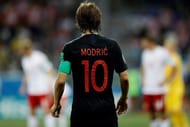
Truth be told, it is very difficult to find any weaknesses in the Croatian side. With Luka Modric and Ivan Rakitic, they arguably have one of the best midfields in the tournament. At striker, they have a great (though slightly past his prime) striker in Mario Mandzukic. They have solid wingers in Ivan Perisic and Ante Rebic. On paper, it appears that their defence is the weak-link: Ivan Strinic, Dejan Lovren and Domagoj Vida do not exactly inspire fear in opposing attacks. In reality however, their defense has been excellent as they have only conceded two goals in the tournament- Denmark’s scruffy opener and a consolation penalty by Gylfi Sigurdsson.
Instead, their most important weakness is a tactical one, spotted by The Ringer’s Ryan O’Hanlon who argued on a Ringer FC podcast that Croatia cross the ball too much considering their midfield talent. Statistics back up O’Hanlon’s assertion- Croatia average the second most crosses per game of any quarterfinalist but have only scored two goals as a result of one. Even more worryingly, only 25% of their crosses have been accurate- again second worst among the quarterfinalists.
Instead of attempting so many inefficient crosses, Croatia should be trying to operate through their world-class midfield. They only average one through ball per game, ridiculous considering the talents of Ivan Rakitic and Luka Modric. If Croatia are to become the ninth team to win the World Cup, then that will have to change.
Brazil: Gabriel Jesus’ Form
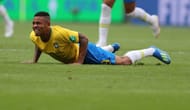
Even more than Croatia, it is very difficult to find any weaknesses in the Brazilian team. Their starting goalkeeper is one of the best in the tournament while their defence has only conceded a single goal so far. Their midfield has the world’s best defensive midfielder in Casemiro(though he will miss the quarterfinal game due to suspension), an ideal box to box midfielder in Paulinho and one of the best creative players in the world in Phillipe Coutinho. They also have a brilliant winger in Willian. Have I mentioned Neymar yet?
They also have a world-class striker in Gabriel Jesus, but you wouldn’t know it if you have been watching any of Brazil’s games so far. That is a little unfair to Jesus as the Manchester City striker has not been horrible in the tournament- making one assist. However considering the strength of Brazil’s attack, one would expect more from their central striker. Jesus has failed to make runs and find space against deeper defences.
Jesus’ link-up play has also been relatively poor as he has failed to gel with the likes of Neymar and Willian. The Manchester City striker has only made 0.8 key passes per game, a number that ranks 8th on the Selecao. An improvement in his form could be key for the favourites.
Belgium: Defensive Vulnerability on Flanks
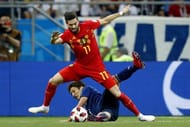
Belgium’s biggest weakness is incredibly obvious when one takes a look at their team-sheet. Roberto Martinez likes to play natural wingers Yannick Carrasco and Thomas Meunier as wing-backs. Even before the tournament, most agreed that this plan of action is flawed. Nonetheless, Martinez has persisted with the system. Even in relatively easy group-stage games against Panama, Tunisia and a second-string English side, this weakness was exposed on multiple occasions.
In their opener against Panama, the minnows almost equalized after a long ball exposed Carrasco. While Micheal Murillo’s shot was saved by Thibaut Courtois, the fact that Belgium’s defence could be exposed by a side like Panama does not bode well for their chances later in the tournament. Tunisia also exploited this weakness when Carrasco was caught out in second-half injury time to allow the North African team a consolation.
Yet, the best example of this weakness came in the Round of 16, when Japan exposed the Red Devils on the counter-attack time and time again. Takashi Inui gave Meunier a horrible time throughout the encounter. On the other end, Carrasco was nowhere to be seen when Genki Haraguchi smashed Japan’s opening goal. If this flaw can be exposed ruthlessly by Japan then imagine what Neymar and Willian will do to Carrasco and Meunier.
Sweden: Lack of Attacking Talent
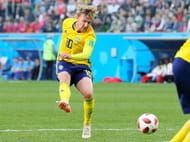
At first glance, this does not seem like a problem for the Swedish team. They have scored six goals in four games. But at the quarter-finals of the World Cup, that is not good enough- every other team left in the competition has scored more. Out of the six goals, only two did not come due to a penalty or a deflection. Moreover, Sweden haven’t been creating high-quality chances at the same rate as most of the competition’s other remaining teams. This is mainly due to the fact that they do not have the same sort of attacking talent as those teams. Sweden’s best-attacking player is Emil Forsberg, who only made 15 starts for RB Leipzig last season.
Sweden are a very underrated team. In qualification, they managed to finish above the Netherlands and defeat Italy in a playoff. At the actual tournament, they have already beaten a doughty South Korea side, thrashed Mexico before scraping past Switzerland. However, against England, the paucity of attacking talent in the Sweden side may cost them.
England: Defensively Error-Prone
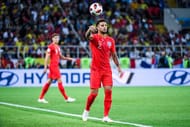
It’s coming home. Or not. England have had their best World Cup in a decade and are certainly favourites against Sweden. At first glance, their main weakness seems to be scoring goals from open play. They have scored a ton of goals but a majority of them have come from set-pieces and penalties. Their only two open-play goals involved a Jesse Lingard peach and an inadvertent Harry Kane deflection. However, the amount of chances created by the Three Lions suggest that this is really not an issue- as they have averaged 2.13 expected goals per game.
Instead, the main issue in the English team is the amount of silly defensive errors that they have made in the competition so far. While Kyle Walker, Harry Maguire and John Stones is a solid defensive trio all together, they have a tendency to make defensive errors. This began in the first game against Tunisia where an absurd Kyle Walker handball led to a Tunisia penalty. Even against Panama, their trio made several errors in the second half (though those came after they had a 5-0 lead). This was clear during the Round of 16 encounter where a Walker error gave Colombia a great chance and Stones’ marker Yerry Mina scored an equalizer.
This is not a new tendency for Walker and Stones- they made a combined fifteen errors leading to goals (according to Squawka) in the past three Premier League seasons (though those reduced this past season). Whether they make their first semi-finals since 1990 will depend on Walker and Stones’ ability to wipe out those mistakes.
